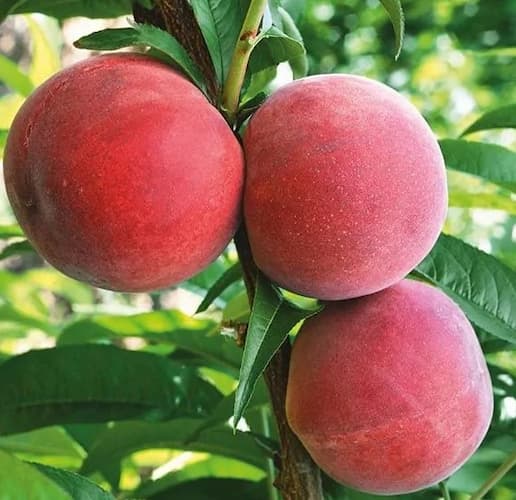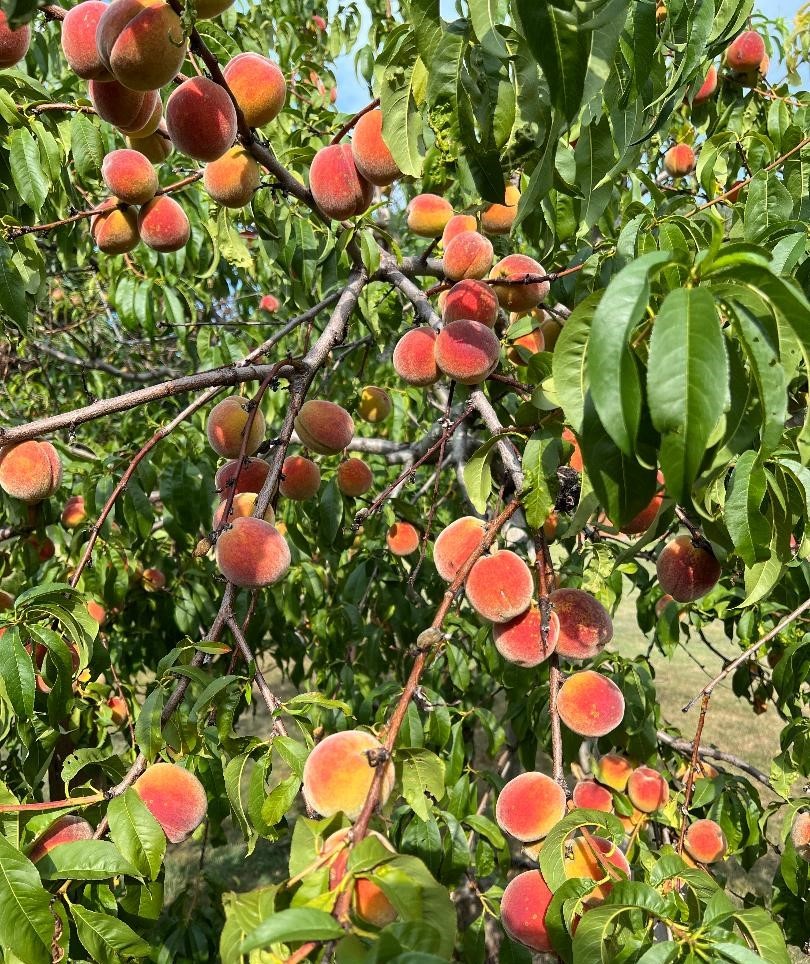How to Grow Peach Trees

About Growing Peach Trees in Your Yard
Ahhh, Peaches!! They are one of the sweet and juicy gems of late summer. Fast growing peach trees, will reward you with golden peaches, in just a few years. They are, however, highly susceptible to both insect infestations and plant disease. To grow peaches successfully, you need to spray the trees regularly.
Spring peach blossoms are a joy to behold. The flowers burst open with a profusion of color. Flower colors include various shades of pink, red, and white, depending upon variety. And, each color has a symbolic meaning. Pink blossoms represent joy and love. Red is a symbol of passion and strength; And, white peach flowers are a symbol of purity.
If you wonder whether you can grow them in your backyard, the answer is definitely yes. With over 2,000 varieties, there is one that is perfect for your yard. Even small yards have room for dwarf peach tree varieties that grow just 5 to 6 feet tall.
Did you Know? Peach pits are poisonous. We don’t think you are going to eat the hard pit. But, we thought you should know.
Peach Tree Specifications
Flower Colors: Varying shades of pink, red, and white, depending upon variety.
Flowers Bloom: Flowers bloom in the spring.
Fruit Ripens: August to early September.
Tree Height: Standard varieties grow 18 to 20 feet, and up to 25 feet tall. Semi-dwarf varieties grow 8 to 12 feet tall. And, dwarf peach trees grow just 5 to 6 feet tall.
Light Requirement: Full sunlight.
Ideal Soil pH: 6.0 – 7.5.
Plant Hardiness Zones: 5 – 9.
Lifespan: They live an average of 15 – 20 years. Peak production occurs when trees are 6 to 12 years old.
Number of Species: Over 2,000 varieties.
Botanical Name: Prunus persica
Light Requirement
Select a planting location where your peach trees will receive full sun. This shouldn’t be a problem with standard varieties. However, keep this in mind when planting dwarf varieties.
Peach trees need 6 to 8 hours or more of bright, direct sunlight. The more direct sunlight the better. Sunshine directly affects fruit quantity and quality.
Peach Tree Propagation
Peach trees are grown from seed…. the “pit”. It takes three or four years to go from the seedling stage to a fruit-producing tree. Most people don’t want to wait that long. They turn to garden nurseries to purchase young trees that can be transplanted into your garden. The trees at your local nursery are a couple of years old. This small tree will still need to grow another year or two to get the first crop of peaches.
You can also graft branches from a peach tree onto other fruit trees. How to Graft Fruit Trees
Planting a Peach Tree
Select a location in your yard that receives full sun. Dig a deep hole. Add plenty of decomposed compost, if available. Mix thoroughly with regular garden soil. If the tree you have bought is inside of a peat pot, leave it in the container. It is helpful (but not required) to slit the container to allow roots to more easily exit the container. While making the slits, be careful not to cut the roots, as you can do more harm than good. If your tree is in a burlap bag, remove the bag. Gently spread the roots in the hole you have dug.
Bury the plant up to where it was in the container. Soak the soil thoroughly. Add more soil if needed.
How to Grow Peach Trees
Once your new tree is planted, it should grow quickly. We recommend staking the tree in its first year of life. Strong winds can bend the young sapling, causing the trunk to grow at an angle. Really strong winds might even cause the tree to sway and damage the roots.
Tip: Fruit tree fertilizer spikes are a great way to boost the growth of your new peach tree. The spike slowly releases a fertilizer specifically formulated for fruit trees.
Established plants should not require any more water than what nature provides. Their roots run deep, to capture the moisture they need from the ground. However, in the first year or two of growth, water deeply around the tree during extended periods of drought.
Each spring, before buds open, apply a dormant oil fruit tree spray. This will kill a variety of insects.
The size and number of peaches are dependent upon several things. As a rule of thumb, more peaches on a tree, result in smaller individual fruit. Sometimes, mother nature pollinates a profusion of blooms. Sometimes frost nips a portion of the blooms. However, in a good year, so many peaches may be on the tree, that the size of the fruit is small. Growers can compensate for this, by removing a few of the baby fruits very early in the season. Should you do this? Probably not in your first few years of growth, as you do not have the experience to judge if there are too many peaches on the tree. But, we do recommend removing any peaches that are damaged by insects, leaving good peaches to grow even bigger.
Late in the season, branches heavily laden with peaches can drop and even break. Removing some of the fruit will ease the problem. And, you can also prop the branches up with 2x2s or 2x4s. Cut a notch on the end of the studs to allow the branches to rest.
Prune the trees annually. See below for how to prune them.
Insects, Pests, and Plant Disease
Peach trees are highly susceptible to both insect infestations and disease. Without regular spraying, peach trees tend to be short-lived. We highly recommend a regular program of spraying for both insects and plant disease. If you use insect and/or disease sprays, we recommend you follow the directions on the label carefully. And by all means, wear protective clothing and a mask when spraying.
Bees and wasps are attracted to the ripe fruit. So, be careful when harvesting the peaches.
More on Insects and Disease
Some animals, most notably raccoons and opossums, like peaches. Trapping, if legal in your area, may be required to control them. Also, deer eat peaches. Use fencing or pest netting, as needed. Also, see Animal control suggestions
Sometimes, birds will peck at the ripening fruit. Pest netting is an effective control measure.

Harvesting Peaches
Harvest fruit before it turns completely ripe. Once it is picked, it will soften and ripen quickly in a matter of just a few days. The fruit will still be hard, making it easier to handle and store. Store fruit in a cool, dry place, out of sunlight.
How to Store Peaches
Fresh peaches have a short shelf life. To eat them fresh, pick ripe fruit off of the tree. They will remain fresh for just a couple of days.
To store the fruit longer, pick them when the fruit is still hard. Here are some ways to store peaches:
Store them in Your Fruit Bowl – Place the fruit in a fruit bowl and place the bowl on the kitchen counter out of direct sunlight. Each day, pick just enough for daily consumption. Then, always rotate the fruit in the bowl, eating the oldest fruit. Discard any overly soft or rotting fruit, as they attract fruit flies.
Store them in the refrigerator – You can store them for several days in the refrigerator. However, it lowers the sugar content.
Make Jams and Jellies – This is a great way to preserve peaches. You’ll love using them later during the winter months.
Canning Peaches – It’s a great way to store them for a longer period of time. The experts say you can store canned peaches for 1 to 2 years. However, over time they lose taste and texture.
Also See:
Pruning Peach Trees
Like other plants, pruning established trees is healthy for them. It results in a bigger crop. Prune peach trees annually in the early late winter or early spring, before the new year’s growth begins.
First, remove dead or unhealthy branches and limbs. Prune in areas where growth is very bushy. This will increase sunlight and air penetration, to help the overall health and growth of the tree. You can also prune branches to maintain a shapely-looking tree.
Recipes
May we suggest:
Related Articles
Also, people who read this article will like:
Please support our site. Shop for:
- rmmatthews100@hotmail.com
- 585-721-6528
- Rochester, NY
©1999-2024 GardenersNet.Com, All Rights Reserved

